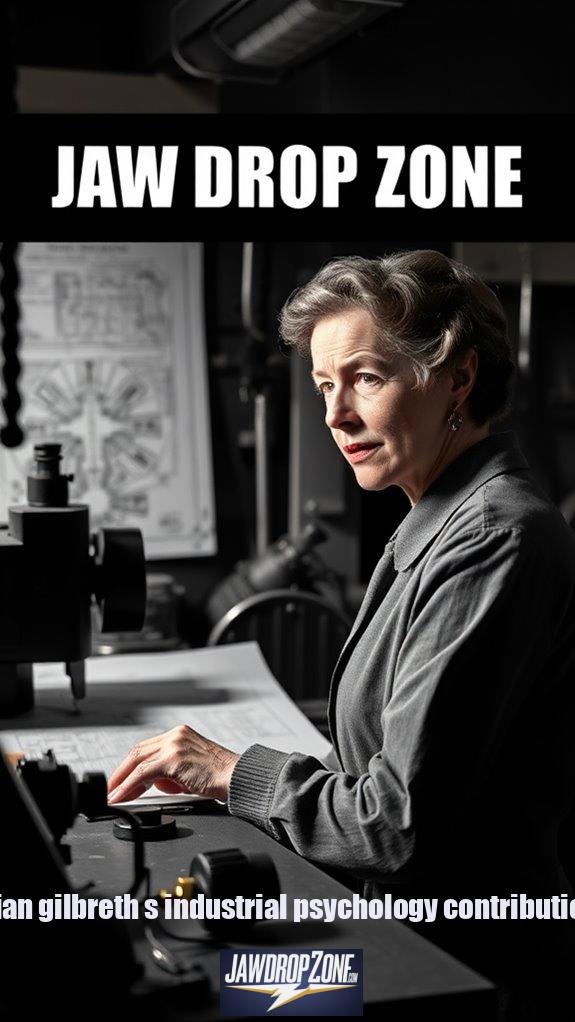Lillian Gilbreth turned the world of industrial psychology upside down! Envision a workplace where job satisfaction is just as essential as productivity—she made it happen. With her pioneering time and motion studies, she revealed shocking truths about efficiency. Did you know regular breaks can skyrocket worker happiness? She even crafted the famous circular kitchen to minimize wasted movement. Intrigued yet? If you think that's impressive, wait until you uncover more of her extraordinary contributions!
Quick Takeaways
- Pioneered an employee-centric approach, emphasizing job satisfaction and psychological comfort to enhance workplace productivity.
- Developed innovative workspace designs, including the circular kitchen layout and ergonomic improvements, to optimize efficiency and comfort.
- Utilized time and motion studies, introducing techniques like therbligs to analyze and improve worker movements for better productivity.
- Advocated for nonfinancial incentives, promoting employee engagement and the importance of feeling valued for overall job satisfaction.
- Left a lasting legacy in industrial psychology, reinforcing that happy workers lead to increased productivity and inspiring modern management practices.
Lillian Gilbreth: A Pioneer in Worker Well-Being

When we think about the evolution of industrial psychology, it's hard not to be amazed by Lillian Gilbreth, a true pioneer who reshaped how we view work and worker well-being.
Envision a world where the psychological comfort of employees is considered just as essential as productivity. Gilbreth did just that! She introduced an employee-centric approach to workplace design, ensuring that job satisfaction and happiness took center stage.
Did you know she revolutionized how we think about workspace efficiency? Her circular kitchen layout wasn't just a clever design; it was about reducing unnecessary motion and fatigue, making life easier for everyone involved. It's almost shocking to think that a simple redesign could lead to greater employee engagement, but that's exactly what she achieved. Time and motion study techniques were foundational to her approach, enabling her to analyze and improve workplace efficiency effectively. Her innovations, including the foot-pedal can, showcased her commitment to enhancing everyday tasks for employees.
Gilbreth also recognized the value of nonfinancial incentives in motivating workers. Instead of mere paychecks, she advocated for fostering a positive environment where employees felt heard and valued.
Envision suggestion boxes becoming tools for engagement, allowing employees to voice their ideas and contribute to their own job satisfaction! She didn't just stop there; she pushed for ergonomic improvements, better lighting, and even regular breaks. Her focus on worker well-being was revolutionary.
I created this website, Jaw Drop Zone, to celebrate such innovators who've greatly impacted our understanding of work.
Gilbreth's legacy continues to influence modern management practices, reminding us that happy workers are productive workers.
Pioneering Time and Motion Studies

Lillian Gilbreth didn't just observe workers; she revolutionized how we comprehend their movements and tasks.
- Cameras capturing every movement
- Chronocyclegraphs revealing timing secrets
- Therbligs categorizing motions
- Efficiency optimization driving results
With her innovative time analysis methods, she transformed workplaces, reducing fatigue and boosting productivity.
Isn't it fascinating how a little observation can lead to monumental change? Welcome to the Jaw Drop Zone!
References
- https://www.ebsco.com/research-starters/history/lillian-evelyn-gilbreth
- https://www.apadivisions.org/division-35/about/heritage/lillian-gilbreth-biography
- https://www.thecareerproject.org/blog/lillian-gilbreth-io-psychology/
- https://en.wikipedia.org/wiki/Lillian_Moller_Gilbreth
- https://alltogether.swe.org/2017/08/remembering-contributions-engineer-lillian-gilbreth/
- https://www.cleanlink.com/hs/article/Lillian-Gilbreth8217s-Study-of-Time-and-Motion–30223
- https://www.worldsupporter.org/en/summary/lillian-m-gilbreths-contributions-development-management-thought-summary-71275
- https://www.autodesk.com/design-make/articles/lillian-gilbreth
- https://www.rcac.purdue.edu/knowledge/gilbreth/bio



